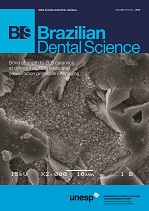Evaluation and Correlation between craniofacial bone densities and C1 and C2 cervical vertebrae using multislice computed tomography.
DOI:
https://doi.org/10.14295/bds.2019.v22i4.1839Abstract
Objectives: To evaluate the use of computed tomography (CT) as an osteoporosis screening tool, evaluating the relation between the bone mineral density (BMD) from maxilla and mandible with the cervical vertebrae, using the Hounsfield units (HU).
Methods: It was included in this study a convenience sample of 118 multislice CT examinations from patients who underwent maxilla, mandible and cervical vertebrae (C1 and C2) simultaneously scans. For each patient, the following regions on both sides of head CT scans were assessed in sagittal slice: above maxillary central and lateral incisors apexes; maxillary tuberosity; mandible head; mandible body endosteum; mandible body trabeculae and vertebrae C1 and C2. HU were measured in each area using a 1.5 cm region of interest (ROI) positioned in the center of the slice.
Results: It was verified that there is a correlation between the BMD of the C1 and C2 vertebrae and the anterior region of the maxilla. It was not found correlation between the vertebrae, C1 and C2,
and the other structures analyzed.
Conclusions: This study showed that this method can be a good screening tool to diagnosis of
osteoporosis, when evaluated the correlation between C1 and C2 vertebrae and anterior region of maxilla. More studies are necessary to evaluate the possibility of using CT as an osteoporosis
screening tool.
Downloads
Downloads
Additional Files
Published
How to Cite
Issue
Section
License
Brazilian Dental Science uses the Creative Commons (CC-BY 4.0) license, thus preserving the integrity of articles in an open access environment. The journal allows the author to retain publishing rights without restrictions.
=================




























